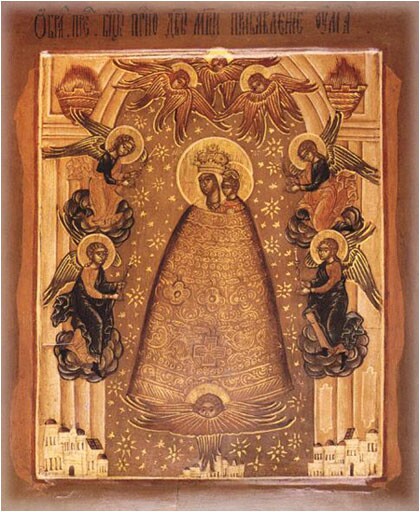There are many icons of Mary in Russian Orthodoxy that are considered chudotvornaya, “wonder-working,” “miracle-working.” A peculiarity of some of these icons is that they are believed to “specialize” in treating certain ailments. There is one, for example, to help women in childbirth. There is another believed to be effective in problems of the mind, whether mental infirmity or helping students perform well in their studies.
An example of the latter is the icon type known as Прибавление ума — Pribavlenie Uma, “Increase of Reason” often translated simply as “Addition of Mind.”

The Church Slavic title written at the top of this icon reads, “Image of the Most Holy Mother of God, Ever Virgin Mary Increase of Reason.”
The peculiar thing about this particular icon type is that, like certain others, it was actually borrowed into Russian Orthodoxy from a western European Roman Catholic image, in fact a very well-known statue in Italy known as “Our Lady of Loreto.” We have already seen that the Buddha found a place in the Calendar of the Russian Orthodox Church under the name St. Ioasaph; in this case an Italian Roman Catholic statue has found a place in the list of Russian Orthodox “wonder-working” icons under the name “Increase of Reason.”
As anyone who has read the group of pious stories known as the Golden Legend knows, the history of saints and images is filled with all kinds of fanciful and imagined and heavily-embroidered stories, and this particular icon goes back to such an imagined story in its Roman Catholic version, which turns out to be quite like the stories one finds in Eastern Orthodoxy about the origins of Marian icons.
When it comes to images and paintings of Mary, there is always the frequently encountered tale that this or that image or painting was created by the evangelist Luke. That is in fact the story that became attached to a blackened image of Mary and the Christ Child that was kept in the shrine of Loreto in Italy. Of course such stories have not a wisp of scientific or historical support, but they served to enhance the importance of such images for pilgrims, and were avidly repeated.
The original Loreto statue was thus one of quite a number of art works attributed by fancy to St. Luke. And even more enhancing was the story that the chapel in which the Loreto image was kept was the original house of Mary, the same one in which she had met the angel Gabriel at the Annunciation, the same one in which Jesus grew up; and that it had been carried through the air to Italy (with a long pause in Croatia) all the way from Palestine in the 13th century, to avoid its falling into the hands of Saracens (these were the times of the Crusades). The house was said to have been seen by shepherds, carried in the sky by the hands of angels. That is very reminiscent of tales told of icons, such as the appearance of the Tikhvin icon, seen by fishermen as it moved miraculously through the air over a lake in northern Russia toward its destination.
To make a long story short, the “Increase of Reason” icon is a painted version of the old, blackened statue of Mary and her child that was kept in the supposed house of Mary in Loreto, Italy. The icon reproduces not only the appearance and garments of the image, but even the shape of the niche with side columns in which the image was kept. That is easy to see when one looks at photos of the Loreto shrine and its image.
The present-day Loreto image in Italy, by the way, is a copy of an earlier image destroyed by fire in 1921.
Here is another icon of the “Increase of Reason” type:
![]()
The inscription reads:
ПРИБАВЛЕНИЕ ОУМА КЛЮЧЬ РАЗЧОУМА ПРЕСВЯТАЯ БОГОРОДИЦЫ
PRIBAVLENIE OUMA KLIUCH RAZOUMA PRESVYATAYA BOGORODITSUI
“[The] Increase of Reason, Key of Understanding Most-holy Mother-of-God”
At the base of Mary’s garment is a “cherubim” (remember that Slavic uses the plural for the singular in this case). The family name saints at left and right are Svyatuiy Iakov Apostol (Holy Jacob/James the Apostle) and Svyataya Irina Muchenitsa (Holy Irina/Irene the Martyress).
Sometimes one may find lines relating to wisdom from the Akathist on examples of this type.
David